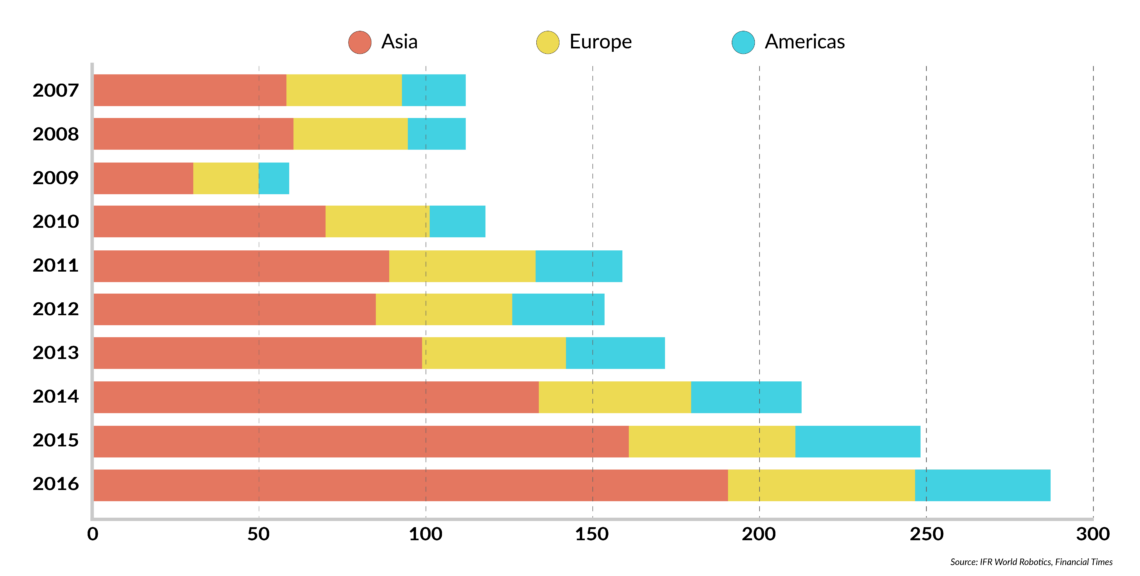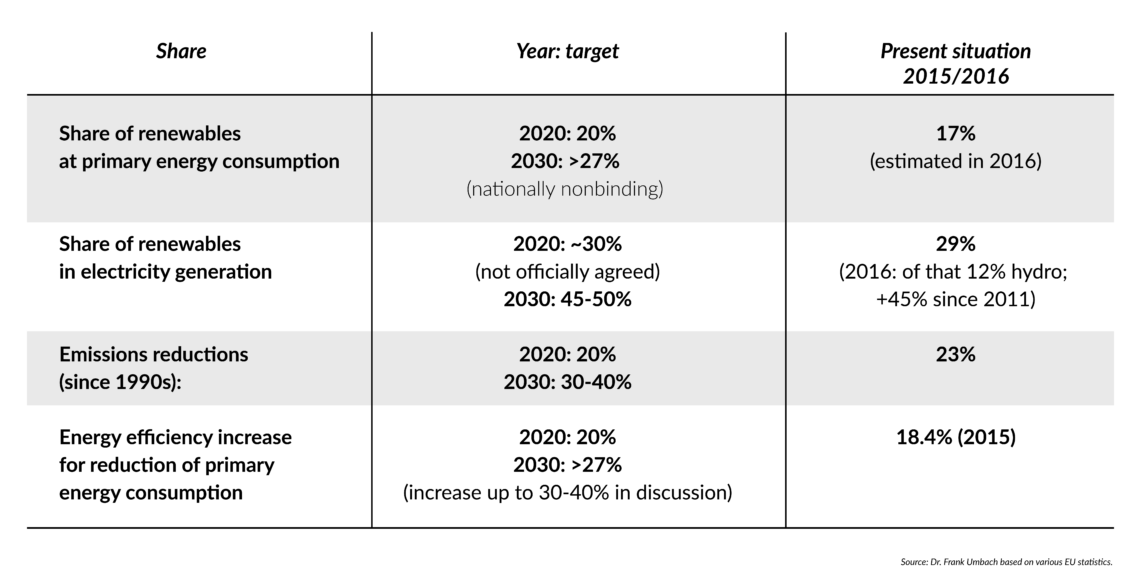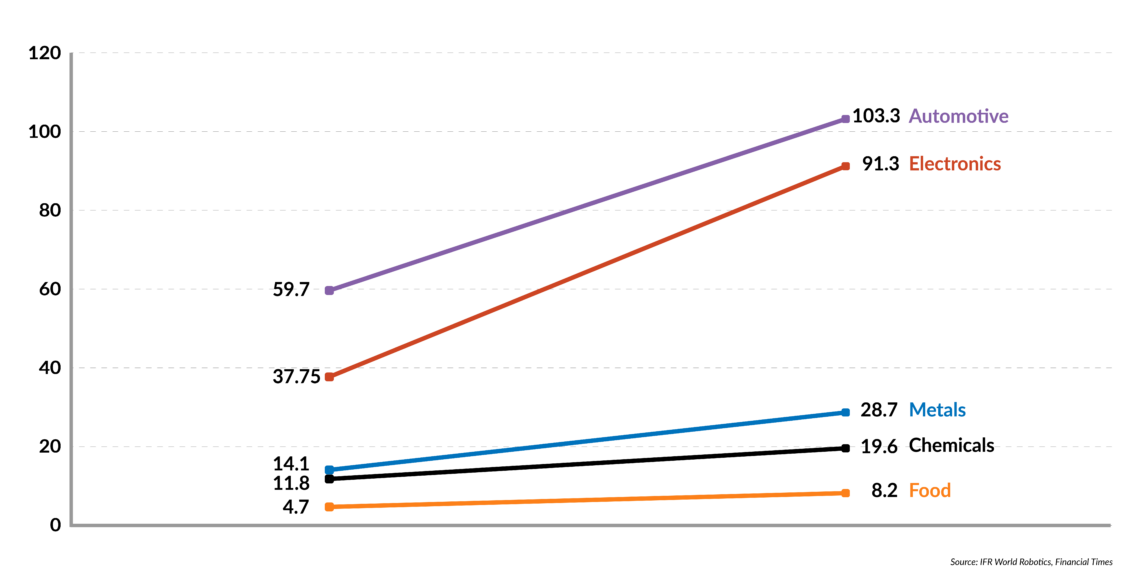Increased electricity usage could derail EU energy targets
The digitization and electrification of the transport and heating sectors, as well as the robotics revolution in industry, have many excited about conserving energy and improving efficiency. But those hopes may be ill-placed: all those factors point toward increased electricity usage in Europe in the years to come.

In a nutshell
- The EU has set ambitious targets for reducing energy consumption
- Innovations in ICT and robotics call for huge increases in electricity demand
- Fossil fuel usage may increase, even despite higher efficiency
The global energy sector is at a crossroads. In the coming years the industry will face the electrification and digitization of the transport and heating sectors, and the “industry 4.0” revolution of robotics and artificial intelligence.
Much of the conversation has focused on the potential of these technologies to conserve energy and improve efficiency. But those hopes should be tempered with the prospect of growing demand for energy, especially in the form of electricity.
Current projections for electricity demand by the European Union and the International Energy Agency (IEA) underestimate these coming changes, potentially making the EU’s energy policies for 2030-2040 unrealistic.
Changing landscape
Though these technologies are developing outside of the energy sector, they will have broad effects on energy markets and industries. Rapid digitization and the widespread use of information and communication technology (ICT) will change basic assumptions about energy markets, business models and consumption patterns. New providers and platforms from outside the sector are taking on established industries. The culture, management and strategies of energy companies are changing too.
Not long ago, there were worries that the world had reached ‘peak oil.’ The world no longer faces a scarcity of fossil fuels.
All of this comes while the sector is transforming for myriad other reasons: the growing use of renewable energy sources, lower global energy demand, higher energy efficiency, divestment from fossil fuels and carbon-intensive sources, decreasing public acceptance of new energy infrastructures, the shale revolution in the United States, and the expanding global liquefied natural gas (LNG) industry. At the same time, critical energy infrastructures are growing increasingly vulnerable to cyberattacks by hacker groups, criminal organizations and state-supported operatives as they become more digitized and linked with the internet.
Not long ago, there were worries that the world had reached “peak oil.” But the world no longer faces a scarcity of fossil fuels. On the contrary, the market is oversupplied; prices are rapidly decreasing and becoming more volatile. These developments have shifted the balance of power between consuming and producing countries. The old sellers’ markets have given way to new buyers’ markets.
Facts & figures
Energy market changes and impacts

The growing use of renewables and a push for energy efficiency and conservation have slowed the increase in global and European energy demand. That has been decoupling the growth in energy demand with annual increases in gross domestic product. Renewables are becoming more efficient, and prices for wind and solar have fallen by as much as 70 percent in recent years. This has convinced many experts that growth in the projected energy demand may continue to decrease (with the notable exception of electricity), while the world population grows to 9 billion by 2040 and living standards continue to rise.
Moving targets
In 2007, the European Union adopted three “20 percent” targets to achieve by the year 2020: a 20 percent reduction in overall energy demand, an expansion of renewables to 20 percent of its primary energy consumption and a 20 percent reduction in greenhouse gas emissions.
Despite some struggles, the EU has largely been on course to reach these goals. The digitization of the energy sector, including the implementation of technologies like smart metering and smart grids, promise to further decrease Europe’s energy demand – and so the EU has adopted even more ambitious targets for 2030. The IEA’s most recent World Energy Outlook projects that by 2040, EU electricity demand will decrease by 0.7-1.0 percent and overall energy demand by 0.8-1.2 percent.
European Commission President Jean-Claude Juncker has made a “digital single market” one of his top priorities. It would facilitate the EU’s transition to clean energy and make the European energy sector more stable, competitive and sustainable. Without effective digitization, the energy sector cannot achieve its ambitious goals for efficiency, quality, cost and environmental/climate mitigation efforts.
Digitization and new technologies can help mitigate the volatility of renewables-based electricity generation.
Digitization and new technologies can help distribute and decentralize renewables, and can link them with smart grids, smart meters and new battery-storage solutions. These advances would at least help mitigate the volatility of renewables-based electricity generation.
German energy utilities are now coping with “Energiewende,” the transition to a low-carbon, sustainable energy supply. German energy companies are striving to become more consumer-focused and service-based, but their share in the digitized retail market is still very small. New business models must be developed according to the “three Ds” – decentralization, decarbonization and digitization. For German energy utilities, the major challenge is not just the digitization itself, but its relationship with the other two Ds.
Facts & figures
EU energy and climate policy targets

Striking a balance
Digitization, electrification and other new technologies have great potential to improve energy efficiency and help the EU achieve its 2030 targets. But that potential has a flipside: introducing the following technologies may also increase energy demand – especially electricity demand – by more than is now projected.
The EU had plans to introduce 200 million smart meters for electricity (accounting for 72 percent of European consumers) and 45 million smart meters for gas (40 percent of consumers). That plan has now slowed due to various circumstances. Its supporters had hoped that these smart meters would save 7-8 percent in annual electricity consumption for private users, but the true numbers may be as low as 1-2 percent – meaning that at the moment, the project is rather costly and ultimately dependent on unpopular changes in consumer behavior.
The “Internet of Things” promises a huge network of smart devices that can coordinate with one another via the internet, creating new business, industries, and even “smart cities.” The sheer number of devices and technologies required to run these networks will make them very resource-intensive. These devices will often have short replacement cycles, and the networks they comprise will create many new cybersecurity vulnerabilities. All of this means increased electricity demand from households and industries.
Producing batteries creates so much carbon dioxide, even before they leave their manufacturing sites, that the overall carbon footprint is already high.
Producing batteries creates so much carbon dioxide, even before they leave their manufacturing sites, that the overall carbon footprint is already high – especially when the processes of mining raw materials like lithium, rare earths and cobalt is included in the analysis.
On top of this, add the energy required to power a self-driving car, which currently collects up to 15 gigabytes per second of data and is equipped with at least 20 sensors, using cameras, radar and lidar to identify its surroundings. The energy required to run self-driving cars and handle those volumes of data (through energy-intensive clouds) is often overlooked, but it is so great that prototypes with a theoretical range of 400 kilometers can, in reality, only drive 200 kilometers autonomously. The computers, sensors and radars on these prototypes can require as much energy as is needed to move the vehicle.
Making the energy sector cleaner may produce higher emissions, at least in the initial phase. Coping with the waste of solar panels and wind turbines is already challenging for renewables businesses, and their recycling process can be very energy intensive.
Blockchain technology is a digital ledger system that can record online transactions, based on decentralized data banks in which sender and receiver are directly linked and require no trusted third parties. Many energy companies are already experimenting with these technologies. BP, Italy’s Eni and Austria’s Wien Energie have together started a pilot program with live trading systems to explore the technology’s implications for the sector.
Blockchain could bring huge changes, such as decentralized markets of production and consumption, streamlined financial processes, and the removal of middlemen and invoicing from many transactions. The technology could allow producers to sell their oil, gas, and electricity directly to consumers. That may one day threaten the very survival of mainstream energy companies. But these advances have proven very energy intensive in terms of the electricity they require.
Digital financial transactions and the tremendous growth of cryptocurrencies are requiring huge increases in computer power. Recent analyses of the processes necessary to trade and create more bitcoin (known as “bitcoin mining”), for example, have shown they are extremely energy intensive.
Facts & figures
Estimated electricity demand of bitcoin mining
(by Digiconomist and others):
- Currently, each bitcoin transaction requires around 147 kilowatt hours (kWh) – the same amount of energy used to power nine homes in the U.S. for one day
- On average, bitcoin runs more than 300,000 transactions daily, requiring more than 16 terawatt hours (TWh) per year – 0.1% of the world’s electricity consumption
- The present total energy used by bitcoin globally could amount to 31 TWh per year – more than Ireland (23 TWh) and 159 other countries consume annually
- Bitcoin’s demand for power increases every day by about 450 gigawatt hours – the same amount of electricity consumed annually by Haiti
- By 2020, bitcoin could reach the equivalent of Denmark’s electricity consumption (around 33 TWh); others have even estimated that in 2019, the rapidly growing bitcoin network could require more electricity than the entire U.S. is currently using
- Around 70 percent of the world’s bitcoin “mining” is based in China, where electricity prices are very low. One facility there has 25,000 computers running a daily bill of $40,000
- The rapidly rising electricity demand means new stress on the grid systems and power production using coal and dirty technologies
- If a new world super-cryptocurrency were to replace the annual Visa and Mastercard process of more than 100 billion transactions, and assuming 100 kWh per transaction, it would consume around 10,000 TWh – almost a third of the world’s current electricity production
If these estimates are confirmed, then this energy usage (and the accompanying climate footprint) could cause electricity blackouts in many countries. Global climate mitigation efforts would not have any positive impact, as global energy demand would completely offset those efforts. Even if such estimates overstate the case, they show how likely it is that we are underestimating future global electricity demand.
The accelerating pace of automation in the energy sector is based on digitization, robotics and artificial intelligence. In 2016, global sales of industrial robots increased by 18 percent to a record $13.1 billion. As a result, about 30 percent of tasks in 60 percent of jobs could ultimately be automated, according to advisory firm McKinsey and Company.
Breakthroughs in robotics could be combined with ICT to allow for electronic communication between equipment and computers in factories – a so-called industrial internet of things. While many focus on implementation and the potential loss of jobs, the prospective energy and electricity demand of this “industry 4.0” is overlooked or marginalized.
Facts & figures
Robots spread across industries
Number of units worldwide, by top sectors (in thousands)

The energy sector is being radically transformed by new technologies. These innovations hold great promise to make the sector cleaner and more energy efficient, but they also raise the prospect of an increase in energy demand, particularly when it comes to electricity (for example in energy-intensive cloud storage). The relationship between demand, innovation, efficiency and other factors is too complex to say precisely what the new balance will look like. But the EU and IEA are now confidently projecting a future with limited growth in global and regional energy demand, which is by no means a sure thing.


